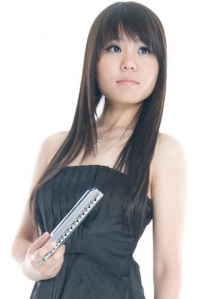[four_fifth]
Chromatic Harmonica Baroque Book
Introduction
In 2017 I attended the annual SPAH harmonica convention in Tulsa Oklahoma. A highlight for me was impromptu baroque duets with SPAH vice president Mike Runyan. He played chromatic harmonica, I played alto recorder. While the chromatic harmonica is a 20th century invention, for 20th century music, our duets from 300 years earlier worked well. After the SPAH convention I compiled this baroque duet collection, so that other chromatic harmonica players might also try this music.

Susan Sauter (by JPS Jogi Pics)
An 18th century music publication, known as an “Opus”, usually comprised six sonatas, sometimes twelve. These sonatas generally had 4 movements, alternating from slow to fast, with tempos and moods indicated by the movement title, e.g. “Allegro” (fast), “Vivace” (lively), “Adagio” (slow).
The music in this collection was mostly written for either baroque flute or recorder. The composers understood these instruments well, and wrote music to fit them. Some pieces will adapt nicely to chromatic harmonica. Others, particularly those by Quantz and Telemann may prove difficult. Moreover baroque ornamentation, a natural fit with recorder and baroque flute fingerings, will present challenges for chromatic harmonicas.

Jyne Lim
I would encourage those wishing to explore this music to buy professional editions wherever possible. I particularly recommend Amadeus Verlag publishers, whose excellent and reasonably priced editions are available online at amadeusmusic.ch
The pieces listed below are arranged in order of increasing difficulty. The easiest by Boismortier come first, the most challenging and undoubtedly the best, by Telemann, are last.
The Music
Joseph Bodin de Boismortier (1689-1755): Suites – Opus 11 and Opus 17
Edited by Nicolas Sceaux – Creative Commons Attribution 3.0

Rocky Lok
Gottfried Finger (1655-1730): Six duets Opus 2
Edited by Notenschreiber – Creative Commons Attribution 3.0
Finger was born in Moravia and moved to London at the end of the 17th century. Unfortunately he published just a single duet Opus, which remains popular with recorder players. Duets in a similar style were written by Mattheson and Croft.
Jean Baptiste Loeillet de Gant (1688c-1720): Six duets arranged from Recorder Sonatas
Edited by Hans-Thomas Müller-Schmidt – Creative Commons Attribution-ShareAlike 4.0
Loeillet published four Opuses, each with 12 recorder sonatas. While not overly demanding, they are well crafted and great fun to play. These 6 duets were arranged by Loeillet from his sonatas.
Johann Joachim Quantz (1697-1773): Three duets Opus 2
Edited by Martin Grayson – Creative Commons Attribution 3.0
Quantz is generally considered the leading 18th century flute player. He was teacher to Frederic the Great and the only individual allowed to criticise the King’s playing. His book “On Playing the Flute” was the definitive 18th century baroque performance manual. While highly active as a composer, he published just one duet Opus, comprising 6 pieces, three are included here.
Georg Philipp Telemann (1681-1767): Six Duets Opus 2
Edited by Hans-Thomas Müller-Schmidt – Creative Commons Attribution 3.0
Of all the composers listed here, Telemann was the most prolific, and was highly regarded by contemporaries such as Quantz and Mattheson. His music was generally good, and often exquisite, particularly his flute and recorder pieces. His Opus 2 duets, included here, are arguably the finest duets of the baroque era. Originally written for flute, this edition has been transposed up a minor third to suit recorders. Other Telemann duets include his ingenious Canonic Sonatas
Playing Suggestions
This music requires advanced reading skills, also an understanding of baroque performance style. Chromatic harmonica players are usually more familiar with 20th century music, e.g. jazz standards, where different reading skills are needed. This 18th century music will be a learning curve for most, best started with the easier Boismortier pieces, which come first.My experience with this music is through recorder, not harmonica (I’m a diatonic player). My chief mentor has been baroque flute player and soprano Amanda Muir, who trained at the Royal Academy of Music in London. We’ve performed together for more than 20 years with our band “Balmain Baroque”, over this time I’ve come to know and love this music.
I’ve also played some of these pieces with the chromatic players pictured in this introduction, namely Evelyn Choon, Aiden Soon and Jyne Lim from the Fresco Harmonica Ensemble in Malaysia, Rocky Lok from Hong Kong, Chu-Ti Chuang, I-Chen Lu and Chih-Hui Yang from the Judy Harmonica Ensemble in Taiwan, and Susan Sauter from Germany, a former World Chromatic Harmonica champion. Baroque music definitely works with chromatic harmonica.

Chu-Ti Chuang, I-Chen Lu, Chih-Hui Yang
For those who cannot find duet partners, an alternate solution is available online at Duetsforone.com. The site has good quality audio recordings of the second part for many of the duets in this collection, done by English recorder player (and instrument maker) Owen Morse-Brown. They are designed as learning tools, are reasonably priced, and include slower versions of the fast movements.
It is my hope that chromatic harmonica players will engage with this music, and bring it into the repertoire. The pieces here were widely tested in the 18th century and found to be great. They remain so today. Please share them with your peers.
Tony Eyers
[/four_fifth]
[one_fifth_last]

Free 200 page Baroque Duet ebook for Chromatic Harmonica players.
[download_link link = ‘https://harmonicatunes.com/wp-content/uploads/2017/12/Chromatic-Harmonica-Baroque-Book.pdf’]Download here[/download_link]
[/one_fifth_last]

